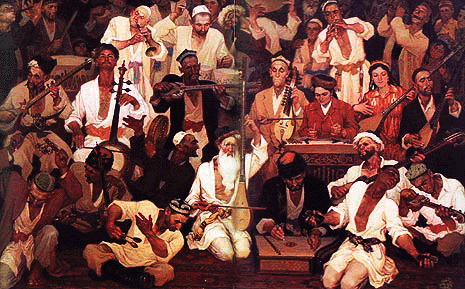Uyghurs & East Turkistan

Who are the Uyghurs?
Uyghurs are a Altai-speaking people who live primarily in East Turkistan (So called Xinjiang, Autonomy Region in Western China). They speak the Uyghur language which is close to other Turkic languages such as Kazakh, Kyrgyz and Uzbek. The Chinese government recognizes the Uyghurs a regional minority and titular people of Xinjiang.
Where is East Turkistan?
East Turkistan (known as Xinjiang, Autonomous region of China) lies on the heart of Asia. The territorial size is 1.626 million kilometer square which is four times the size of California. It has ten neighbouring countries which are Mongolia, Tibet, India, Kazakhstan, Kyrgyzstan, Tajikistan, Afghanistan, Pakistan, Russia and China.
The population of Uyghurs in East Turkistan is around 30 millions and the capital city Urumqi.


Uyghur Culture
Uyghur culture is a product of a long history in the region of East Turkestan, or the XUAR, influenced by a being a people along the silk road, with historically significant cities like Kashgar, being the centres of trade, cultural and religious intermingling for thousands of years.
As a result, silk and cotton is central to Uyghur clothing- consequently being turned in to scarves worn as headscarves or turned to the popular atlas pattern or dress. Men traditionally wear doppas – a patterned cap - with women wearing their hair in braids which traditionally showed her marital status.
Being predominantly Muslim in faith, Uyghur diet omits alcohol and pork. Staples in their diet includes polo – rice dish with carrots and lamb, laghman - thick noodles with a vegetable and meat sauce, and other sides like manta - steamed dumplings, nan - bread and baked samsa - dumplings.


Ramadan, Eid and Nowruz (the spring equinox) are some of the most significant festivals for Uyghur where religious traditions are practiced and communities gather and food is shared. This hospitality is an important aspect of Uyghur culture where traditions are passed down, communities bond and grow over shared meals and events such as a women’s chay or over music and dance in a meshrep gathering.
Uyghur culture differs from other Islamic countries with the influence of Sufism. This is demonstrated with shrines (mazar) to saints that Uyghurs make pilgrimages too, leaving gifts and prayers. These pilgrimages are vital to Uyghur’s bond with both their religion and their land with a majority of these shrines near or in the Taklimakan desert, being sacred, holy places for centuries.
Uyghur History
The Uyghur people have a deep, complex history in Central Asia spanning thousands of years. The decade of the 740’s AD led to the forming of Uyghur Empire in Orkhun Valley (Karabalghasun) which lies in today’s Northeast border of Uyghur homeland - Mongolia. The Uyghur empire declined after the effects of an epidemic and following attack by Kyrgyz tribes. The population divided into three groups lead by three princes, and moved towards three different places in the Empire, and continued ruling the Uyghur empire.


The Uyghurs, over the following millennia developed a distinctive culture under the rule of successive local kingdoms within the wider sphere of Central Asia. During the 10th-11th century reign of the Karakhanids, mosques, schools, bridges, and caravanserais were constructed in the cities. Kashgar became a centre of learning and Uyghur - Turkic literature. Among the most important works of the period are Kutadgu Bilig (Blessed Knowledge) written by Yusuf Balasaghuni, and Lughat-at-Turk (The Turkic dictionary) by Mahmud of Kashgar.
The region gradually converted to Islam between the 10th and 14th centuries, led by leaders like Sultan Bughra Khan who fought an important battle to bring Islam to the neighbouring Buddhist kingdom of Khotan. In 1210, the Uyghurs submitted to Mongol Empire and became ‘civil servants’ to the Mongol administration, which adopted the old Uyghur script. Ancient cities like Kashgar demonstrate the significance of Uyghurs as a people situated along the Silk Road being a hub of trade and cultural exchange. Yarkand Khanate of the 16th century was also an important centre of Uyghur culture, where the Twelve Muqam musical suites are believed to have been created. In the 17th century, the Kashgar region was ruled by a dynasty of Sufis led by the famous Apaq Khoja whose tomb lies outside Kashgar.


In the 1750’s, the Uyghur region was conquered by the Manchu-Qing Dynasty which gradually took more direct control of the region, in 1881 renaming it as ‘Xinjiang’ (New Territory) as part of the colonization of the region alongside efforts to assimilate the population under Chinese rule. As a result, a series of rebellions broke out, and two independent East Turkistan Republics were established in 1933 and 1945 before Mao Zedong’s Red Army occupation with direct support from the Soviet Union in 1949. In 1955, the Xinjiang Uyghur Autonomous Region was established. However, Uyghur autonomy was never properly established, and Uyghurs have suffered periods of state violence and repression of their culture and religion, especially during the Cultural Revolution of the mid-20th century.
